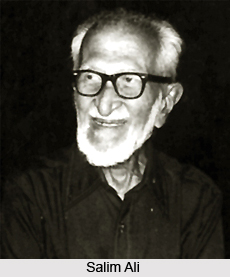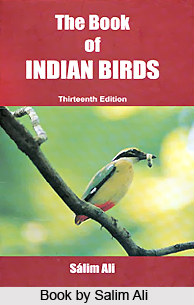 Salim Ali was an Indian naturalist who did path-breaking work in natural history, classified the distribution and ecology of over 1000 bird species that inhabit South Asia. Further, he contributed significantly for their conservation by promoting a broader view that saw avifauna as an intrinsic part of a larger mosaic of landscapes. His work, though rooted in taxonomy, opened up insights into the way birds behaved and lived. Salim Ali was one of the most senior and most eminent naturalists of India.
Salim Ali was an Indian naturalist who did path-breaking work in natural history, classified the distribution and ecology of over 1000 bird species that inhabit South Asia. Further, he contributed significantly for their conservation by promoting a broader view that saw avifauna as an intrinsic part of a larger mosaic of landscapes. His work, though rooted in taxonomy, opened up insights into the way birds behaved and lived. Salim Ali was one of the most senior and most eminent naturalists of India.
Early Life of Salim Ali
Salim Moizuddin Abdul Ali was born on 12th of November, 1896 into a Muslim family of Bombay (now Mumbai). He was the youngest child of his family. He lost his parents at a very young age and was brought up by his maternal uncle. Salim Ali initially attended school at Zanana Bible Medical Mission Girls High along with his sisters. Later he moved to St. Xavier`s College, Mumbai. When he was 13 years of age, he suffered from chronic headaches. Because of this reason he used to drop out of studies very often. He managed to pass his matriculation exam in the year 1913. As a schoolboy in 1907, he shot a sparrow that was hard to identify and his quest led him to the offices of the Bombay Natural History Society. He was introduced to the serious study of different variety birds` species by the secretary of the Bombay Natural History Society (BNHS,) W. S. Millard. The wide variety of bird specimens that he discovered on the shelves of its museum aroused in him a deep curiosity about the natural world that stayed with him till his death.
Professional Life of Salim Ali
Giving up a lucrative future in the mining industry, he opted for a more uncertain life, working first as a naturalist-guide, then studying abroad and finally roping in several princely houses to underwrite his surveys of the bird life of their states. The seemingly frail figure of `Salim Ali Doctor Sahib` as he was known in his later years gave no hint of his reserves of stamina. As a young man, he rode to Europe on a motorcycle to attend an assembly of ornithologists. Even in his seventies he would retrace his own journey of the 1940s on camel back into Kutch, and follow it shortly after by a tour of the cold deserts of the Ladakh plateaus.
 He had published his first work, `The Book of Indian Birds`, three years before Corbett`s debut as an author. It became a classic and it still remains popular sixty years after it was first published. Though not the first to put together a field guide, he reached out to a larger audience then any of his predecessors. The colour plates accompanied by the notes in his inimitable prose had an appeal that cut across political divisions and social cleavages.
He had published his first work, `The Book of Indian Birds`, three years before Corbett`s debut as an author. It became a classic and it still remains popular sixty years after it was first published. Though not the first to put together a field guide, he reached out to a larger audience then any of his predecessors. The colour plates accompanied by the notes in his inimitable prose had an appeal that cut across political divisions and social cleavages.
Contributions of Salim Ali
Salim Ali was very influential and ensured the survival of Bombay Natural History Society. He managed to save this institution by writing and seeking financial help to the then Prime Minister Jawaharlal Nehru. Further, he also guided the development of ornithology in India. He helped in finding efficiently and socially significant fields where the study of birds could be financed. He also had an influence in the foundation of economic ornithology division within Indian Council for Agricultural Research. The end of princely rule put a question mark on the fate of old hunting reserves. The reserves were particularly unpopular in denying peasants fodder or firewood access. One place in grave danger was the Keoladeo Ghana of Bharatpur, a wetland created by the local prince as a shooting ground for ducks and geese that flocked there every winter. At the insistence of Salim Ali and his colleagues, shooting was forbidden during the monsoon when Storks and other waders bred in its confines. But the threat in the early 1950s was more serious for it could imperil the life cycles of the wetland itself. Such public interventions from Salim Ali, while notable, were exceptional.
Awards and Recognition
Salim Ali received numerous honorary doctorates as well as awards. In the year 1953, he was awarded the `Joy Gobinda Law Gold Medal` by the Asiatic Society of Bengal. In 1967 he received Gold Medal of the British Ornithologists` Union. Moreover, Salim Ali received honorary doctorates from Aligarh Muslim University in 1958, from Delhi University in 1973 and from Andhra University in 1978. In the year 1967, he received J Paul Getty Wildlife Conservation prize and in 1969 he was given the John C. Phillips memorial medal of International Union for Conservation of Nature and Natural Resources. In the year 1973, Salim Ali was given the Pavlovsky Centenary Memorial Medal by the USSR Academy of Medical Science. In 1958, he was conferred with the Padma Bhushan Award and the Padma Vibhushan Award in 1976 by the Government of India.
Dr. Salim Ali died in 1987 in Mumbai at the age of 91 years after suffering from prostate cancer. Salim Ali`s work spoke for itself. His extensive studies of birds would alert readers to the wider connections in the landscape, especially those between forests and living organisms. In the early years of Independence, along with the ichthyologist (zoologist who studies fishes) Sunder Lal Hora, Salim Ali was one of the few scientists active in influencing public policy on conservation issues of the country. Government of India established the Salim Ali Centre for Ornithology and Natural History (SACON) at Coimbatore in the year 1990.











